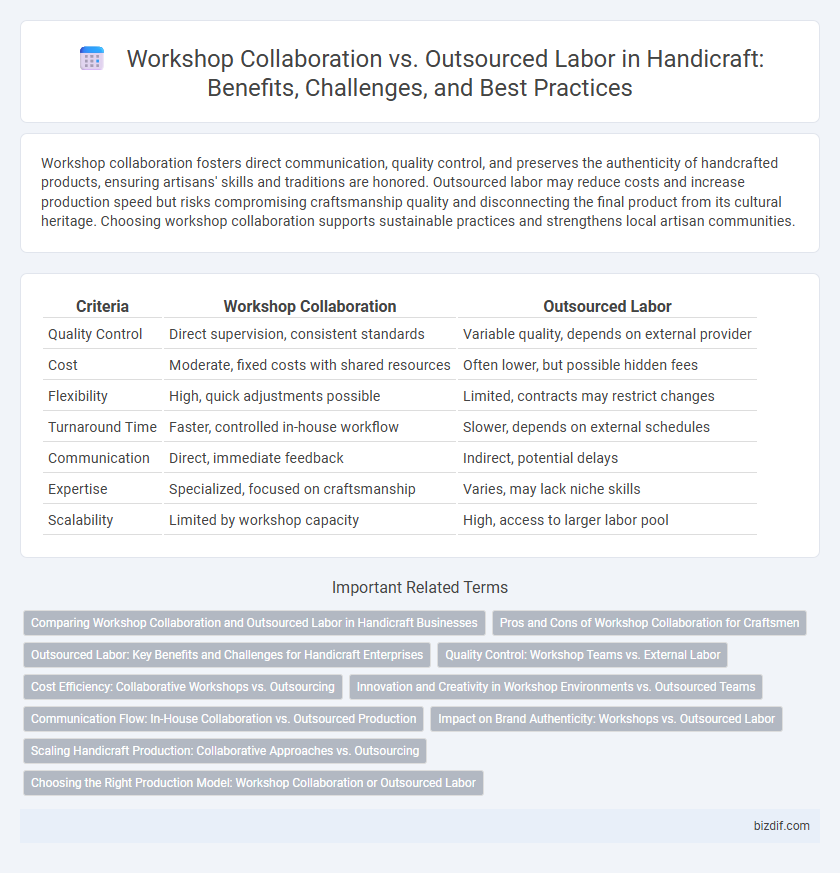Workshop collaboration fosters direct communication, quality control, and preserves the authenticity of handcrafted products, ensuring artisans' skills and traditions are honored. Outsourced labor may reduce costs and increase production speed but risks compromising craftsmanship quality and disconnecting the final product from its cultural heritage. Choosing workshop collaboration supports sustainable practices and strengthens local artisan communities.
Table of Comparison
| Criteria | Workshop Collaboration | Outsourced Labor |
|---|---|---|
| Quality Control | Direct supervision, consistent standards | Variable quality, depends on external provider |
| Cost | Moderate, fixed costs with shared resources | Often lower, but possible hidden fees |
| Flexibility | High, quick adjustments possible | Limited, contracts may restrict changes |
| Turnaround Time | Faster, controlled in-house workflow | Slower, depends on external schedules |
| Communication | Direct, immediate feedback | Indirect, potential delays |
| Expertise | Specialized, focused on craftsmanship | Varies, may lack niche skills |
| Scalability | Limited by workshop capacity | High, access to larger labor pool |
Comparing Workshop Collaboration and Outsourced Labor in Handicraft Businesses
Workshop collaboration in handicraft businesses fosters direct control over quality and design, enabling artisans to maintain traditional techniques and customize products extensively. Outsourced labor often reduces production costs and increases scalability but may compromise craftsmanship consistency and cultural authenticity. Choosing between these approaches depends on balancing cost efficiency with the value of handcrafted uniqueness and brand reputation.
Pros and Cons of Workshop Collaboration for Craftsmen
Workshop collaboration enables craftsmen to maintain direct control over the quality and design of their handicrafts, ensuring authenticity and promoting skill development within a close-knit team. This approach fosters creative synergy and allows efficient communication, reducing the risk of errors and delays often associated with outsourced labor. However, workshop collaboration may require higher upfront investment in tools and workspace, and scaling production can be limited by the available skilled workforce.
Outsourced Labor: Key Benefits and Challenges for Handicraft Enterprises
Outsourced labor in handicraft enterprises offers cost savings and access to specialized skills that enhance product variety and quality. Challenges include maintaining consistent craftsmanship standards and ensuring ethical labor practices across remote suppliers. Leveraging digital communication tools can improve coordination and quality control in outsourced production processes.
Quality Control: Workshop Teams vs. External Labor
Workshop teams provide superior quality control as they maintain direct oversight throughout the crafting process, ensuring consistency and attention to detail in every piece. In contrast, outsourced labor often lacks stringent supervision, leading to variable craftsmanship standards and potential quality issues. Maintaining in-house workshop collaboration enables artisans to preserve traditional techniques and guarantee the authenticity of handmade products.
Cost Efficiency: Collaborative Workshops vs. Outsourcing
Collaborative workshops enhance cost efficiency by leveraging shared resources, reducing overhead costs, and fostering skilled craftsmanship within a controlled environment. Outsourced labor may lower immediate expenses but often incurs hidden costs such as quality control, communication delays, and less flexibility in customization. Investing in workshop collaboration ensures sustainable savings through improved quality and streamlined production processes.
Innovation and Creativity in Workshop Environments vs. Outsourced Teams
Workshop collaboration nurtures innovation and creativity by fostering direct interaction among artisans, enabling real-time feedback and spontaneous idea generation. In contrast, outsourced labor often limits creative synergy due to geographic and communication barriers, which can hinder the development of unique handcrafted designs. Maintaining an in-house workshop environment enhances craftsmanship quality and encourages continuous experimentation with traditional and modern techniques.
Communication Flow: In-House Collaboration vs. Outsourced Production
In-handicraft workshops, in-house collaboration facilitates direct communication and real-time feedback, enhancing precision and craftsmanship quality. Outsourced production often faces communication delays and misunderstandings due to geographic and cultural distances, impacting project timelines and consistency. Efficient information exchange in-house supports adaptive problem-solving, whereas outsourced labor demands robust coordination mechanisms to align production standards.
Impact on Brand Authenticity: Workshops vs. Outsourced Labor
Workshop collaboration preserves brand authenticity by showcasing artisan skills and maintaining direct quality control, ensuring each product reflects traditional craftsmanship. Outsourced labor risks diluting the brand's heritage through inconsistent workmanship and potential loss of cultural significance. Emphasizing in-house workshops strengthens customer trust by delivering genuine, handcrafted items aligned with the brand's unique story.
Scaling Handicraft Production: Collaborative Approaches vs. Outsourcing
Scaling handicraft production through workshop collaboration fosters quality control and preserves artisanal techniques, leveraging skilled craftsmen within a cohesive environment. Outsourced labor offers cost efficiency and increased output by utilizing external suppliers, but may risk consistency and craftsmanship authenticity. Balancing collaborative workshops with selective outsourcing enables sustainable growth while maintaining the unique value of handmade products.
Choosing the Right Production Model: Workshop Collaboration or Outsourced Labor
Choosing the right production model in handicraft depends on factors like quality control, cost-efficiency, and customization needs. Workshop collaboration fosters direct communication, ensuring artisanal craftsmanship and timely feedback, while outsourced labor offers scalability and lower production costs but may risk consistency and brand integrity. Evaluating product complexity and market demands helps artisans balance creativity with operational efficiency for optimal results.
Workshop collaboration vs Outsourced labor Infographic

 bizdif.com
bizdif.com